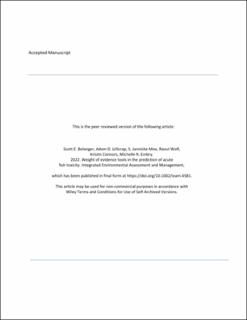| dc.description.abstract | Acute fish toxicity (AFT) is a key endpoint in nearly all regulatory implementations of environmental hazard assessments of chemicals globally. Although it is an early tier assay, the AFT assay is complex and uses many juvenile fish each year for the registration and assessment of chemicals. Thus, it is imperative to seek animal alternative approaches to replace or reduce animal use for environmental hazard assessments. A Bayesian Network (BN) model has been developed that brings together a suite of lines of evidence (LoEs) to produce a probabilistic estimate of AFT without the testing of additional juvenile fish. Lines of evidence include chemical descriptors, mode of action (MoA) assignment, knowledge of algal and daphnid acute toxicity, and animal alternative assays such as fish embryo tests and in vitro fish assays (e.g., gill cytotoxicity). The effort also includes retrieval, assessment, and curation of quality acute fish toxicity data because these act as the baseline of comparison with model outputs. An ideal outcome of this effort would be to have global applicability, acceptance and uptake, relevance to predominant fish species used in chemical assessments, be expandable to allow incorporation of future knowledge, and data to be publicly available. The BN model can be conceived as having incorporated principles of tiered assessment and whose outcomes will be directed by the available evidence in combination with prior information. We demonstrate that, as additional evidence is included in the prediction of a given chemical's ecotoxicity profile, both the accuracy and the precision of the predicted AFT can increase. Ultimately an improved environmental hazard assessment will be achieved. | en_US |
